Abstract
The synthesis of dihydrotestosterone is catalyzed by steroid 5 alpha-reductase isozymes, designated types 1 and 2. Mutation of type 2 results in male pseudohermaphroditism, in which the external genitalia are phenotypically female at birth. Two striking and unexplained features of this disorder are that external genitalia of affected males undergo virilization during puberty and that these individuals have less temporal hair regression. The tissue-specific and developmental expression patterns of the 5 alpha-reductase isozymes were investigated by immunoblotting. The type 1 isozyme is not detectable in the fetus, is transiently expressed in newborn skin and scalp, and permanently expressed in skin from the time of puberty. There was no qualitative difference in 5 alpha-reductase type 1 expression between adult balding vs. nonbalding scalp. The type 2 isozyme is transiently expressed in skin and scalp of newborns. Type 2 is the predominant isozyme detectable in fetal genital skin, male accessory sex glands, and in the prostate, including benign prostatic hyperplasia and prostate adenocarcinoma tissues. Both isozymes are expressed in the liver, but only after birth. These results are consistent with 5 alpha-reductase type 1 being responsible for virilization in type 2-deficient subjects during puberty, and suggest that the type 2 isozyme may be an initiating factor in development of male pattern baldness.
Full text
PDF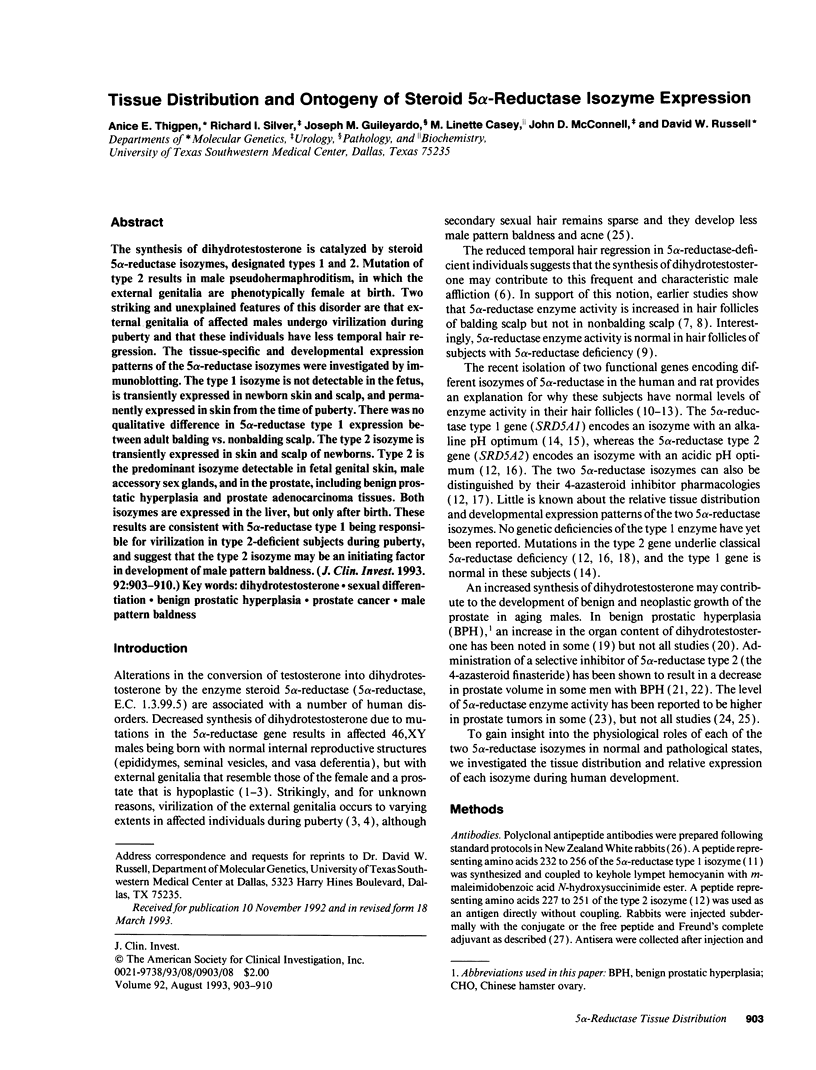
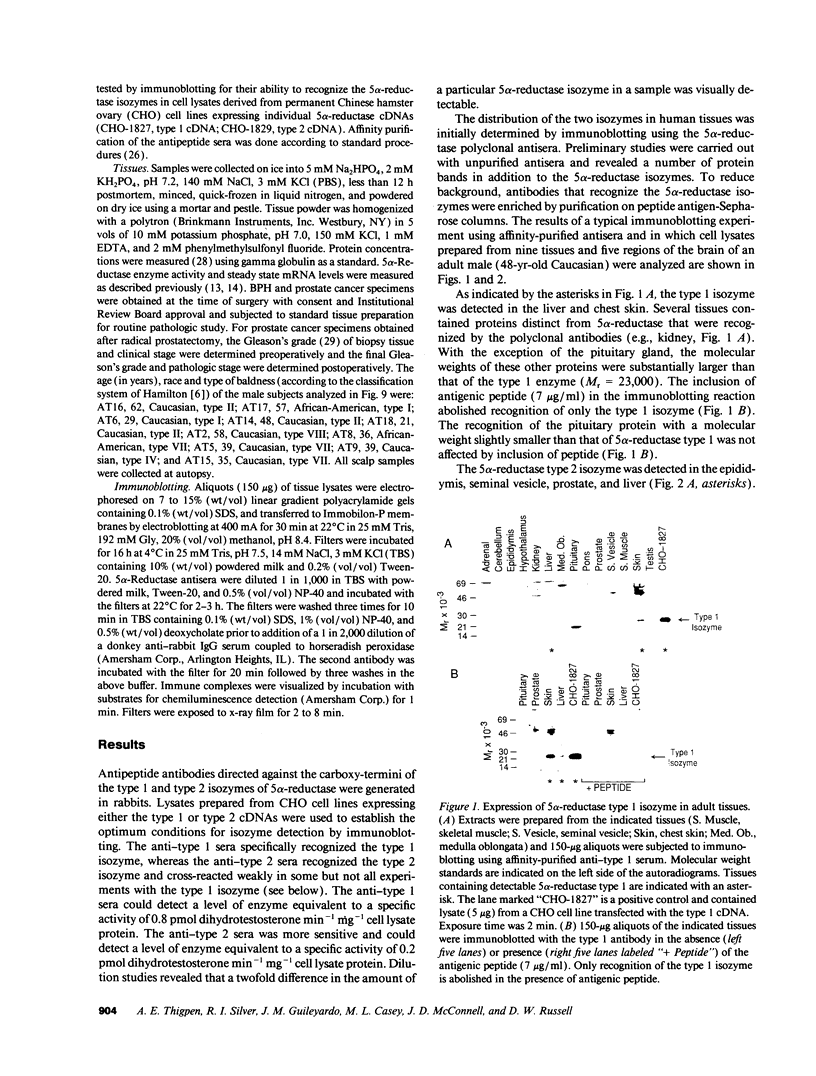
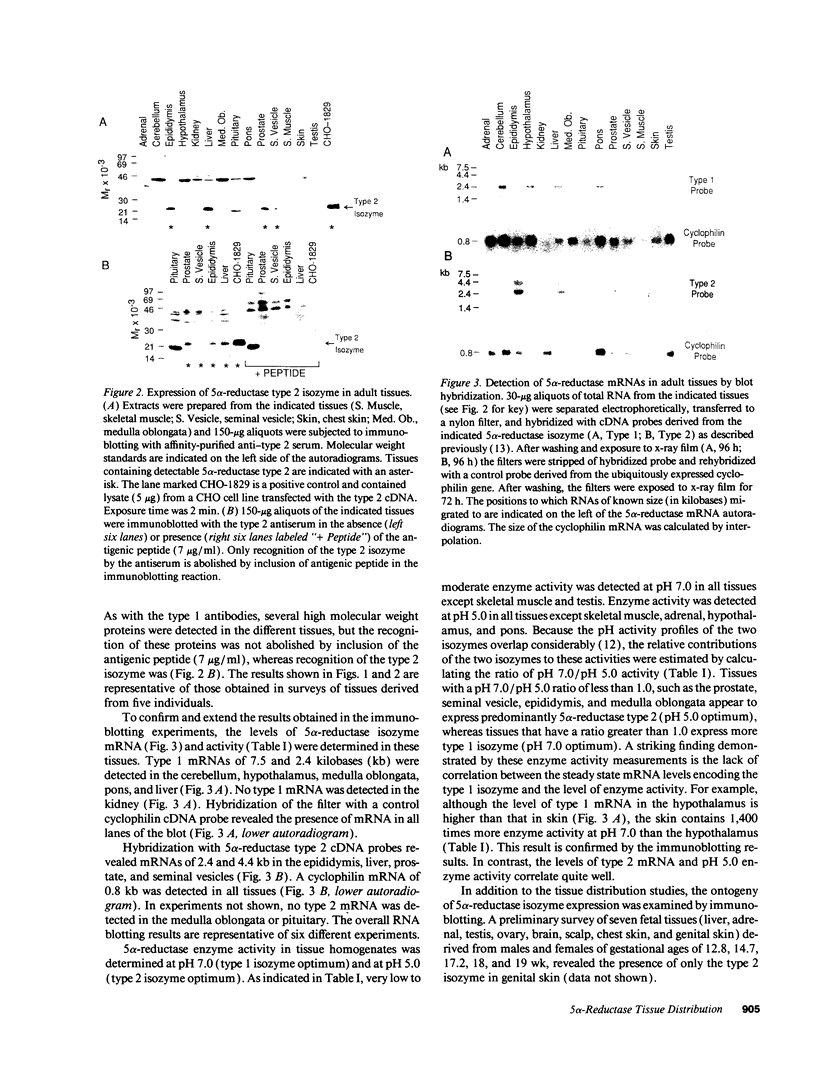

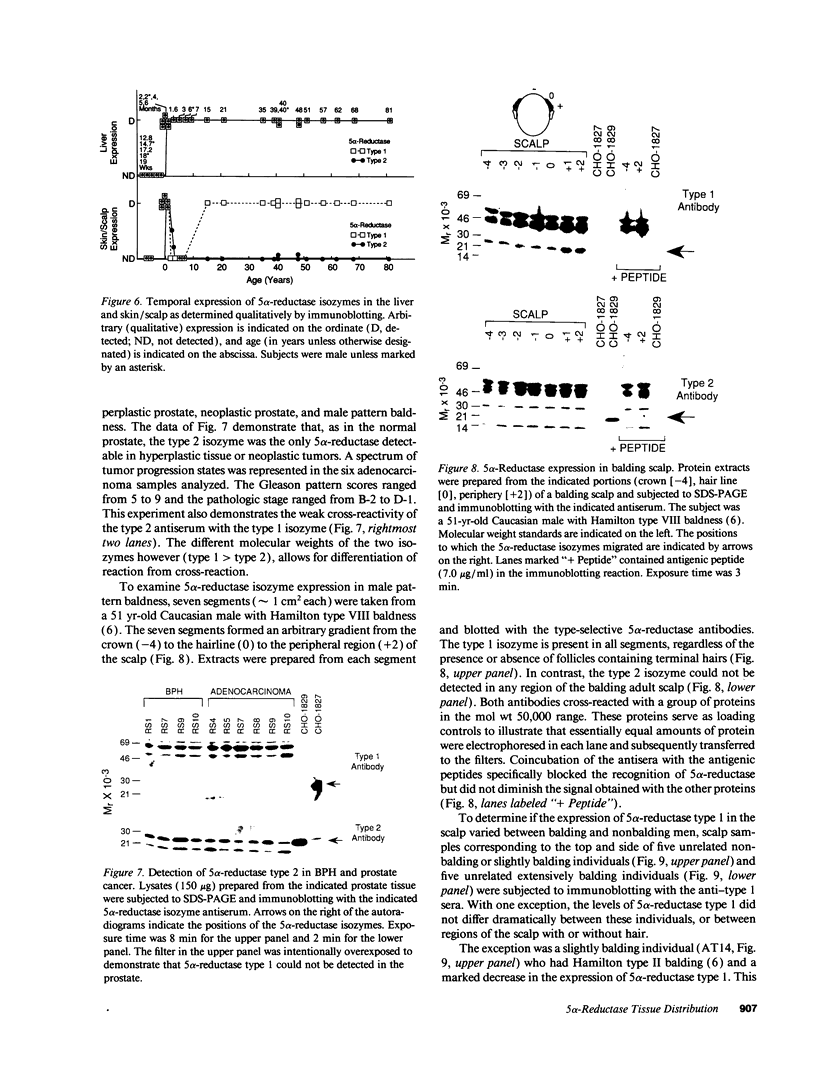
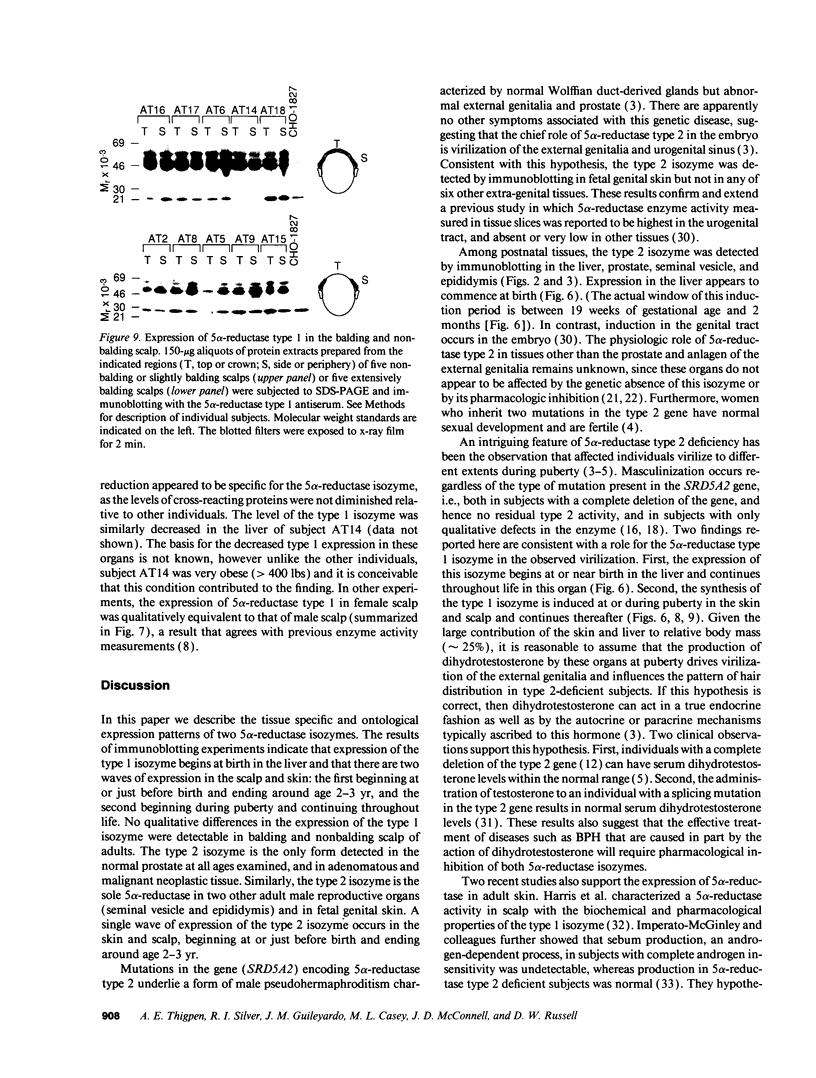
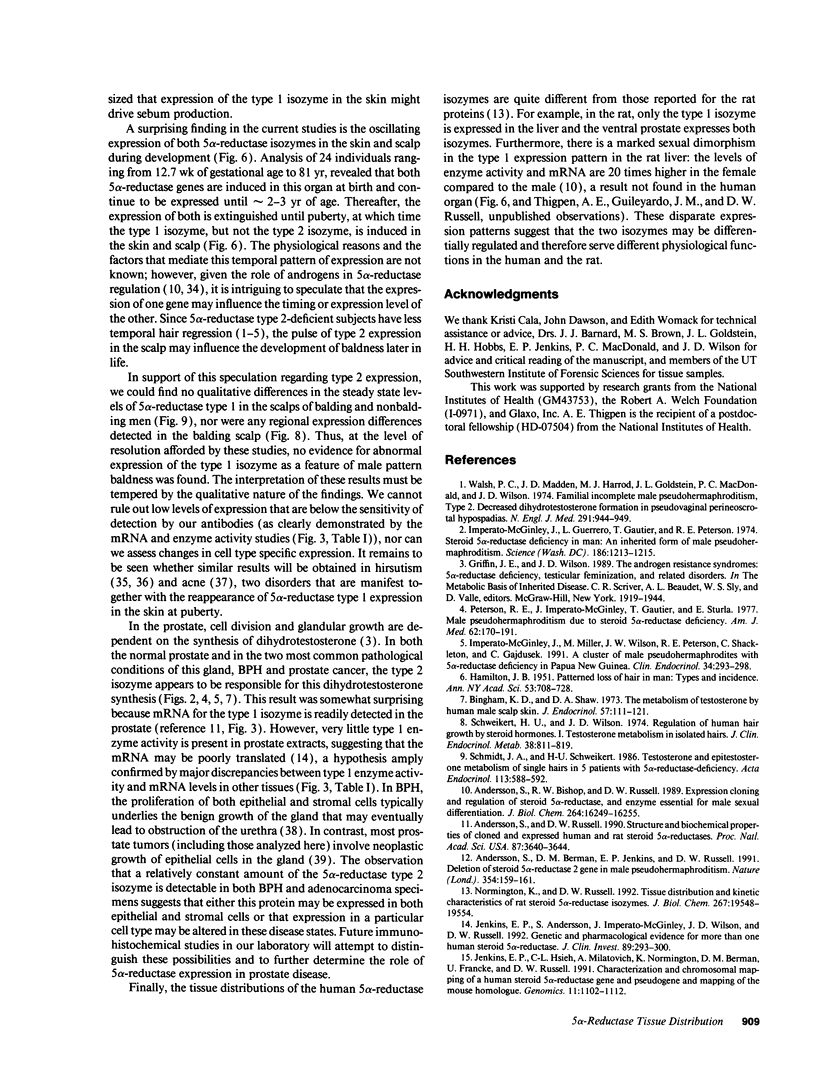

Images in this article
Selected References
These references are in PubMed. This may not be the complete list of references from this article.
- Andersson S., Berman D. M., Jenkins E. P., Russell D. W. Deletion of steroid 5 alpha-reductase 2 gene in male pseudohermaphroditism. Nature. 1991 Nov 14;354(6349):159–161. doi: 10.1038/354159a0. [DOI] [PMC free article] [PubMed] [Google Scholar]
- Andersson S., Bishop R. W., Russell D. W. Expression cloning and regulation of steroid 5 alpha-reductase, an enzyme essential for male sexual differentiation. J Biol Chem. 1989 Sep 25;264(27):16249–16255. [PMC free article] [PubMed] [Google Scholar]
- Andersson S., Russell D. W. Structural and biochemical properties of cloned and expressed human and rat steroid 5 alpha-reductases. Proc Natl Acad Sci U S A. 1990 May;87(10):3640–3644. doi: 10.1073/pnas.87.10.3640. [DOI] [PMC free article] [PubMed] [Google Scholar]
- Bingham K. D., Shaw D. A. The metabolism of testosterone by human male scalp skin. J Endocrinol. 1973 Apr;57(1):111–121. doi: 10.1677/joe.0.0570111. [DOI] [PubMed] [Google Scholar]
- Bradford M. M. A rapid and sensitive method for the quantitation of microgram quantities of protein utilizing the principle of protein-dye binding. Anal Biochem. 1976 May 7;72:248–254. doi: 10.1006/abio.1976.9999. [DOI] [PubMed] [Google Scholar]
- Brendler C. B., Follansbee A. L., Isaacs J. T. Discrimination between normal, hyperplastic and malignant human prostatic tissues by enzymatic profiles. J Urol. 1985 Mar;133(3):495–501. doi: 10.1016/s0022-5347(17)49040-9. [DOI] [PubMed] [Google Scholar]
- Bruchovsky N., Rennie P. S., Batzold F. H., Goldenberg S. L., Fletcher T., McLoughlin M. G. Kinetic parameters of 5 alpha-reductase activity in stroma and epithelium of normal, hyperplastic, and carcinomatous human prostates. J Clin Endocrinol Metab. 1988 Oct;67(4):806–816. doi: 10.1210/jcem-67-4-806. [DOI] [PubMed] [Google Scholar]
- George F. W., Russell D. W., Wilson J. D. Feed-forward control of prostate growth: dihydrotestosterone induces expression of its own biosynthetic enzyme, steroid 5 alpha-reductase. Proc Natl Acad Sci U S A. 1991 Sep 15;88(18):8044–8047. doi: 10.1073/pnas.88.18.8044. [DOI] [PMC free article] [PubMed] [Google Scholar]
- Gormley G. J., Stoner E., Bruskewitz R. C., Imperato-McGinley J., Walsh P. C., McConnell J. D., Andriole G. L., Geller J., Bracken B. R., Tenover J. S. The effect of finasteride in men with benign prostatic hyperplasia. The Finasteride Study Group. N Engl J Med. 1992 Oct 22;327(17):1185–1191. doi: 10.1056/NEJM199210223271701. [DOI] [PubMed] [Google Scholar]
- HAMILTON J. B. Patterned loss of hair in man; types and incidence. Ann N Y Acad Sci. 1951 Mar;53(3):708–728. doi: 10.1111/j.1749-6632.1951.tb31971.x. [DOI] [PubMed] [Google Scholar]
- Harris G., Azzolina B., Baginsky W., Cimis G., Rasmusson G. H., Tolman R. L., Raetz C. R., Ellsworth K. Identification and selective inhibition of an isozyme of steroid 5 alpha-reductase in human scalp. Proc Natl Acad Sci U S A. 1992 Nov 15;89(22):10787–10791. doi: 10.1073/pnas.89.22.10787. [DOI] [PMC free article] [PubMed] [Google Scholar]
- Hudson R. W., Wherrett D. Comparison of the nuclear 5 alpha-reduction of testosterone and androstenedione in human prostatic carcinoma and benign prostatic hyperplasia. J Steroid Biochem. 1990 Feb;35(2):231–236. doi: 10.1016/0022-4731(90)90279-2. [DOI] [PubMed] [Google Scholar]
- Imperato-McGinley J., Gautier T., Cai L. Q., Yee B., Epstein J., Pochi P. The androgen control of sebum production. Studies of subjects with dihydrotestosterone deficiency and complete androgen insensitivity. J Clin Endocrinol Metab. 1993 Feb;76(2):524–528. doi: 10.1210/jcem.76.2.8381804. [DOI] [PubMed] [Google Scholar]
- Imperato-McGinley J., Guerrero L., Gautier T., Peterson R. E. Steroid 5alpha-reductase deficiency in man: an inherited form of male pseudohermaphroditism. Science. 1974 Dec 27;186(4170):1213–1215. doi: 10.1126/science.186.4170.1213. [DOI] [PubMed] [Google Scholar]
- Imperato-McGinley J., Miller M., Wilson J. D., Peterson R. E., Shackleton C., Gajdusek D. C. A cluster of male pseudohermaphrodites with 5 alpha-reductase deficiency in Papua New Guinea. Clin Endocrinol (Oxf) 1991 Apr;34(4):293–298. doi: 10.1111/j.1365-2265.1991.tb03769.x. [DOI] [PubMed] [Google Scholar]
- Jenkins E. P., Andersson S., Imperato-McGinley J., Wilson J. D., Russell D. W. Genetic and pharmacological evidence for more than one human steroid 5 alpha-reductase. J Clin Invest. 1992 Jan;89(1):293–300. doi: 10.1172/JCI115574. [DOI] [PMC free article] [PubMed] [Google Scholar]
- Jenkins E. P., Hsieh C. L., Milatovich A., Normington K., Berman D. M., Francke U., Russell D. W. Characterization and chromosomal mapping of a human steroid 5 alpha-reductase gene and pseudogene and mapping of the mouse homologue. Genomics. 1991 Dec;11(4):1102–1112. doi: 10.1016/0888-7543(91)90038-g. [DOI] [PubMed] [Google Scholar]
- Jenkins J. S., Ash S. The metabolism of testosterone by human skin in disorders of hair growth. J Endocrinol. 1973 Nov;59(2):345–351. doi: 10.1677/joe.0.0590345. [DOI] [PubMed] [Google Scholar]
- Normington K., Russell D. W. Tissue distribution and kinetic characteristics of rat steroid 5 alpha-reductase isozymes. Evidence for distinct physiological functions. J Biol Chem. 1992 Sep 25;267(27):19548–19554. [PubMed] [Google Scholar]
- Peterson R. E., Imperato-McGinley J., Gautier T., Sturla E. Male pseudohermaphroditism due to steroid 5-alpha-reductase deficiency. Am J Med. 1977 Feb;62(2):170–191. doi: 10.1016/0002-9343(77)90313-8. [DOI] [PubMed] [Google Scholar]
- Price P., Wass J. A., Griffin J. E., Leshin M., Savage M. O., Large D. M., Bu'Lock D. E., Anderson D. C., Wilson J. D., Besser G. M. High dose androgen therapy in male pseudohermaphroditism due to 5 alpha-reductase deficiency and disorders of the androgen receptor. J Clin Invest. 1984 Oct;74(4):1496–1508. doi: 10.1172/JCI111563. [DOI] [PMC free article] [PubMed] [Google Scholar]
- Russell D. W., Schneider W. J., Yamamoto T., Luskey K. L., Brown M. S., Goldstein J. L. Domain map of the LDL receptor: sequence homology with the epidermal growth factor precursor. Cell. 1984 Jun;37(2):577–585. doi: 10.1016/0092-8674(84)90388-x. [DOI] [PubMed] [Google Scholar]
- Sansone G., Reisner R. M. Differential rates of conversion of testosterone to dihydrotestosterone in acne and in normal human skin--a possible pathogenic factor in acne. J Invest Dermatol. 1971 May;56(5):366–372. doi: 10.1111/1523-1747.ep12261252. [DOI] [PubMed] [Google Scholar]
- Schmidt J. A., Schweikert H. U. Testosterone and epitestosterone metabolism of single hairs in 5 patients with 5 alpha-reductase-deficiency. Acta Endocrinol (Copenh) 1986 Dec;113(4):588–592. doi: 10.1530/acta.0.1130588. [DOI] [PubMed] [Google Scholar]
- Schweikert H. U., Wilson J. D. Regulation of human hair growth by steroid hormones. I. Testerone metabolism in isolated hairs. J Clin Endocrinol Metab. 1974 May;38(5):811–819. doi: 10.1210/jcem-38-5-811. [DOI] [PubMed] [Google Scholar]
- Siiteri P. K., Wilson J. D. Dihydrotestosterone in prostatic hypertrophy. I. The formation and content of dihydrotestosterone in the hypertrophic prostate of man. J Clin Invest. 1970 Sep;49(9):1737–1745. doi: 10.1172/JCI106391. [DOI] [PMC free article] [PubMed] [Google Scholar]
- Siiteri P. K., Wilson J. D. Testosterone formation and metabolism during male sexual differentiation in the human embryo. J Clin Endocrinol Metab. 1974 Jan;38(1):113–125. doi: 10.1210/jcem-38-1-113. [DOI] [PubMed] [Google Scholar]
- Stoner E. The clinical effects of a 5 alpha-reductase inhibitor, finasteride, on benign prostatic hyperplasia. The Finasteride Study Group. J Urol. 1992 May;147(5):1298–1302. doi: 10.1016/s0022-5347(17)37547-x. [DOI] [PubMed] [Google Scholar]
- Thigpen A. E., Davis D. L., Gautier T., Imperato-McGinley J., Russell D. W. Brief report: the molecular basis of steroid 5 alpha-reductase deficiency in a large Dominican kindred. N Engl J Med. 1992 Oct 22;327(17):1216–1219. doi: 10.1056/NEJM199210223271706. [DOI] [PubMed] [Google Scholar]
- Thigpen A. E., Davis D. L., Milatovich A., Mendonca B. B., Imperato-McGinley J., Griffin J. E., Francke U., Wilson J. D., Russell D. W. Molecular genetics of steroid 5 alpha-reductase 2 deficiency. J Clin Invest. 1992 Sep;90(3):799–809. doi: 10.1172/JCI115954. [DOI] [PMC free article] [PubMed] [Google Scholar]
- Thigpen A. E., Russell D. W. Four-amino acid segment in steroid 5 alpha-reductase 1 confers sensitivity to finasteride, a competitive inhibitor. J Biol Chem. 1992 Apr 25;267(12):8577–8583. [PubMed] [Google Scholar]
- Thomas J. P., Oake R. J. Androgen metabolism in the skin of hirsute women. J Clin Endocrinol Metab. 1974 Jan;38(1):19–22. doi: 10.1210/jcem-38-1-19. [DOI] [PubMed] [Google Scholar]
- Walsh P. C., Hutchins G. M., Ewing L. L. Tissue content of dihydrotestosterone in human prostatic hyperplasis is not supranormal. J Clin Invest. 1983 Nov;72(5):1772–1777. doi: 10.1172/JCI111137. [DOI] [PMC free article] [PubMed] [Google Scholar]
- Walsh P. C., Madden J. D., Harrod M. J., Goldstein J. L., MacDonald P. C., Wilson J. D. Familial incomplete male pseudohermaphroditism, type 2. Decreased dihydrotestosterone formation in pseudovaginal perineoscrotal hypospadias. N Engl J Med. 1974 Oct 31;291(18):944–949. doi: 10.1056/NEJM197410312911806. [DOI] [PubMed] [Google Scholar]



















